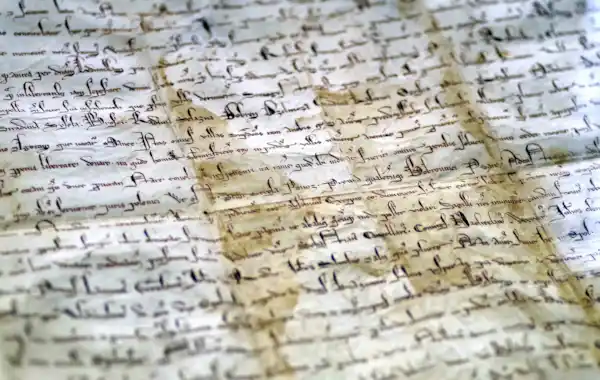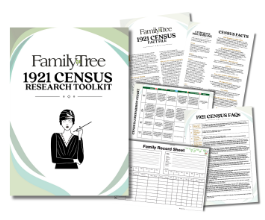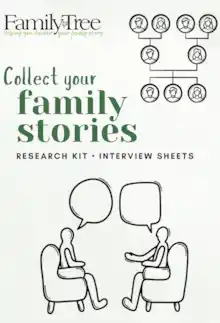Unlock centuries-old family history with this in-depth guide exploring medieval records across the British Isles. From the Norman Conquest to the end of Plantagenet rule in 1485, discover how to trace local landowners, uncover hidden surnames, and navigate key feudal documents. Featuring expert guidance and a detailed parish case study, this is essential reading for anyone who wants to get back to before the 1500s.
Researching medieval ancestors: quick links
Note that the feudal system developed with differences among each of the countries and the terminology varies too.
When was the medieval period?
For the purposes of this guide, the medieval period is being viewed as the period from the Norman conquest in 1066 to the battle of Bosworth Field in 1485, which signalled the end of the rule of the Plantagenets.
Essentially this ignores the early medieval period (c. 450-1066).
Records do exist from that period especially later Saxon charters, but it was the Normans who introduced large-scale record keeping, a lot of which contains genealogical information as well as fascinating information for the local historian.
A significant number of records, some dating back to the Norman Conquest, and increasingly from the mid-13th century amazingly survive. A large amount has been either transcribed and or translated; a process which began in the early 19th century and continues today.
A large proportion of these records have and are continuing to be digitised and many are freely available online.
What medieval records might we realistically find?
Most of us would love to trace our ancestral lines back beyond parish records, but unless you are descended from nobility or landed gentry this is practically impossible.
However, although the Norman Conquest brought with it a massive upheaval in daily life it also brought the feudal system and a sudden increase in record keeping for the purposes of taxation.
This means that you can find out an incredible amount about your locality going back to the Norman Conquest, including who held the land and who lived there. As you trace records of land holding families you may be able to connect into one of your own ancestral lines.
Surnames were not in use before the Norman conquest and only began to be introduced as population size increased.
Most people recorded in early documents after the Normans arrived were either named in connection with their place of origin, their residence, their occupation or as the son, daughter or wife of someone.
So, we might have:
- John de Plesses, a Norman noble
- Edmund de Dudden, probably an Anglo Saxon
- Hugh the Cook
- William the Blacksmith
- Robert son of Richard, who might alternatively been 'Robert Fitz Richard' if the person was a Norman
In order to study medieval records, it is important to have a basic understanding of the feudal system as well as terminology related to landholding and the monetary system of the period.
A lot of the documents though digitised are still in Latin, and although a basic knowledge of Latin helps it is not necessary to be a Latin scholar.
Most documents are formulaic and once the formula has been grasped, they become easier to follow, and Artificial Intelligence, though not perfect, is already becoming a game changer in language translation.
Three important points about medieval records
The first point to remember about the really old records of a city/town/village is that:
- They are likely to be written on rolls of parchment (hence the term ‘Court Rolls’ and the like)
- They are likely to be illegible compared with modern records with letters that, for the most part will be unrecognisable
- They are likely to be written in Latin.
More than any other point, it is this last one, mentioning the ‘L’ word that is likely to have any family historian running for the hills! Latin is at best a difficult language to master and at times it is contradictory beyond belief!
This aside, there are ways around the problem, and simple programmes that family historians can use to give a half decent Latin translation.
Types of medieval record
So, what kind of records can we expect to find? Well, this really depends on the area of the UK the ancestor you are researching lived.
Let's use Nottingham and the surrounding districts as an example:
- Nottingham Borough Records – 8 volumes from 1155 to 1835. These are most probably the most informative documents about day-to-day life in the medieval town.
- Nottingham Borough Court Rolls – 1303 to 1475
- Burgess Pleas
- Foreign Pleas
- Jeyes Derbyshire Charters
Nationally:
- A survey of medieval Winchester
- Canterbury under the Angevin kings
- Early Assize Rolls for the county of Northumberland
- Publications of the Surtees Society
It’s well worth getting in touch with your local county archives who will let you know which documents are available, and don’t forget the UK National Archives.
About the feudal system
This was brought in by William the Conqueror in 1066.
When William arrived, the Anglo-Saxon system, which had been based on common ownership of land under the nobility, was ended. The feudal system was to follow and was based on the King owning all the land and consequently generating income from rents, fines and grants of privileges.
William divided up the land by keeping 20% for his own use, granting 25% to the church and granting the remainder to his lords and barons in about 170 parcels known as baronies.
These men were the tenants in chief and held this land in return for military service to the King. Hence baronies were divided into what were called knight’s fees, meaning a lord or baron had to provide a mounted knight when requested for each knight’s fee.
A knight’s fee
A knight’s fee was the amount of land needed to maintain a fully equipped mounted knight annually.
There was no standard size for a barony or a knight’s fee, it tended to be based on land value and quality.
Obviously if a lord or baron held land worth more than one knight’s fee, he needed other knights to provide this service, so he would sub-let his land to knights, who in turn could sub-let the land to vassals or peasants, who actually worked the land.
Knight’s fees were also divided into Manors, which were essentially a settlement surrounded by land, of which there were about 6,000 in England.
The holder of a knight’s fee was required to serve the king for a period of forty days at his own expense when requested.
William was also shrewd with the establishment of the feudal system, ensuring no one lord held large areas of land in one compact geographical area in order to prevent them establishing a rival power base.
An example of this was William’s half-brother Richard Fitz Gilbert who was granted land worth 60 knight’s fees spread over Norfolk, Suffolk, Kent and Essex.
Over time the system of knight’s fees changed from military obligation to a cash payment due to the cost to the king of keeping large numbers of knights in the field if the 40-day period was insufficient, as well as paying men at arms and providing weapons.
Cash payments also allowed the king to pay for men at arms and weapons without it affecting his personal wealth. This enabled the knight’s fee system to be subdivided, so we begin to see men holding land for a fraction of a knight’s fee.
Land, dwelling & tenant terms
The Normans introduced many new terms for areas of land which appear in documents along with some Saxon and Viking terms which are sometimes interchangeable. Most of these are however no longer in use and seem strange and archaic to the modern student of history.
The longest surviving term was the acre which has Saxon origins and was officially superseded by the hectare (2.47 acres) when the UK began to adopt the metric system in 1965 prior to joining the European Economic Community (later the EU) in 1973.
The acre is still however commonly used in agriculture and many field names incorporate the term.
Norman land terms were based on areas that could be ploughed by teams of oxen. The acre was an area of land that could be ploughed by a single furrow plough pulled by a team of eight oxen in one day.
Turning a team of eight oxen was tricky, so acres at this time tended to be long narrow strips of land. Acres were measured in square yards, the yard being a measurement of three feet or 90 cm. An acre as a strip of land tended to be 220 yards long by 22 yards wide (4840 square yards).
“Furrow long”
Anyone familiar with horse racing will recognise that 220 yards is what is known as a furlong, from “furrow long”; furrow referring to the mark in the soil made by the plough. Cricket fans will know that 22 yards is the length of a cricket wicket and is also known historically as a chain; hence in old terminology an acre was a furlong in length and a chain in width.
Land terminology to help your research
Some common terms introduced by the Normans which you will encounter in records are:
- Geld - Tax
- Carucate (Saxon-Hide) - the amount of land that could be ploughed by a team of eight oxen in a season and was also called a ploughland. This varied due to the soil type but was usually standardised as 120 acres
- Virgate - a quarter of a carucate approximately 30 acres
- Bovate (Viking-Oxgang) - an eighth of a carucate approximately 15 acres
- Ferling - a sixteenth of a carucate approximately 7.5 acres
- Rod or Rood - a quarter of an acre
- Demesne - land held by a lord for his own use rather than being sub-tenanted
- Waste - an area of woodland or common grazing land
- Appurtenances - rights that belong to a property
- Enfeoffment - granting of land
- Quitclaim - a document renouncing a person’s right to land
- Seisin - taking possession of land you have title to
- Croft - an area of land attached to a dwelling
- Toft - a dwelling with an enclosed garden
- Messuage - a dwelling with outbuildings and land.
- Frankalmoign - a type of feudal tenure whereby religious houses hold land in exchange for praying for the souls of the benefactor and his ancestors.
Types of tenants
- Tenant in chief - a lord or baron who holds land directly from the king.
- Knight - a high-ranking sub-tenant who is required to provide military service when required.
- Vassal or Freeman - a free sub-tenant who could also be a tradesman as well as an agricultural worker, and who was also required to provide military service when required.
- Villein or Villen - an unfree sub-tenant who was tied to the land and was also expected to provide labour and service to the lord when required.
- Bordar - a peasant of lower economic status than a villein, equivalent to a smallholder.
- Drenge - a northern term for a freeman holding land in return for service.
Rights of tenants
Various rights were assigned to tenants in a barony, usually depending on their status.
Hunting in the forest was heavily policed as a lot of forest was designated Royal Forest, which required the permission of the king to enter. It is estimated that one quarter of England was designated as such by the 13th century.
Forest at this time meant woods, heaths, moorland, wetland and wasteland; usually areas unsuitable for agriculture but ideal for game.
- Free warren - the right of a high-ranking tenant to hunt small game which included roe deer, hares, rabbits, pheasant and partridge.
- Venary - the right of a high-ranking tenant to hunt the beasts of the forest which was restricted to red deer, wild boar, hares and wolves.
- Distrain - the right granted to a high-ranking tenant to seize property or land from a subtenant in lieu of rent.
- Herbage - the right to graze livestock on common land.
- Pannage - the right to allow pigs to forage in woodland.
- Estovers - the right to take dead wood e.g. fallen trees for fuel.
- Vett - the right to take green wood from a forest.
- Turbary - the right to cut peat, heather and turf for fuel.
- Piscary - the right to take fish from a river or stream.
Payments required of tenants
Geld or Rent - the amount paid annually for the land. Around the time of the early Norman conquest period this was around six shillings per hide/carucate. Tenants with less land would obviously pay less and payments to the lord of the manor could be in goods rather than cash. However, cash was required by the king.
- Relief - a tax on inheritance
- Merchet - a tax on marriage. If a tenant wanted to marry, he had to get his lord’s permission and pay merchet for the privilege.
- Amercement - essentially a small fine for an offence such as failing to report your marriage.
- Cornage - a tax on grazing of horned cattle.
- Suit of multure - tenants were required to mill their grain at the lord’s mill and give a percentage of the grain as a payment. This does not seem to be a fixed amount and varies from a 12th to a 30th.
- Villeins were also required to take part in large community projects including building and maintaining structures such as mills and bridges.
Monetary terms
All monetary terms in this series of articles will be in the form of pounds shillings and pence or marks. Many in the earlier documents are in Latin numerals.
For those who are not familiar with coinage pre-decimalisation, there were 12 pennies in a shilling and 20 shillings in a pound.
There was also another monetary unit used by the Normans which was the mark. A mark appears to be a strange amount, being 13 shillings and 4 pennies but this actually equates to two thirds of a pound.
The transcription and translation of many Latin records into English kept the form of “l s d” for pounds shillings and pence often with Roman numerals.
The term l s d comes from the Latin librae, solidi and denarii. So monetary amounts could be recorded in the Roman form as x. li v. s iii. d or alternatively 10l 5s 3d rather than £10 5s 3d which would be more familiar to those aged over 60. Interestingly the £ sign is actually a stylised L with a line through it. The symbol li rather than l is often used in the Roman numeral form to avoid confusion with the latin L which represented 50.
King Edward I (1272-1307) introduced the groat which was worth 4d, so three groats made a shilling.
Subsequent kings issued other gold and silver coins which are no longer in use such as nobles, angels and ryals.
Until the 14th century however, despite there being different monetary terms there was mainly only one coin in circulation and that was the silver penny, which harks back to the Anglo Saxon King Offa in the 9th century.
Consequently, any monetary exchange would be in pennies and there are 240 in a pound so £10 would have been 2,400 pennies. Half and quarter penny amounts were also in use, and this would be achieved by literally cutting the coin up.
Understandably, lower ranking people often tended to use a system of barter rather than coinage. The silver penny remained in circulation until 1707.
Henry VII the first Tudor monarch was responsible for minting the first shilling and first pound coin.
Could your ancestor have castle connections?
For centuries, castles were centres of defence, governance, and employment — and many modern surnames reflect this heritage.
Castle-related surnames include:
- Noble and administrative: Knight, Steward, Chamberlain, Marshall
- Occupational: Butler, Archer, Fletcher, Cook, Carter, Porter, Mason, Squire
- Even Castle itself — or variants like Cassell and Castell — may indicate a link to castle life.
While not all such names confirm medieval ancestry, they offer clues to ancestral occupations or residences.
Claim your free 1921 Census toolkit
Sign up for the free Family Tree newsletter, and we’ll send you a link to our free census kit featuring a fact file, FAQs, timeline, family record sheet, and the 'Census Comparison Chart' detailing how the information collected in the census changed over the decades.
It's the perfect resource to help you start exploring the records in the 1921 census!









